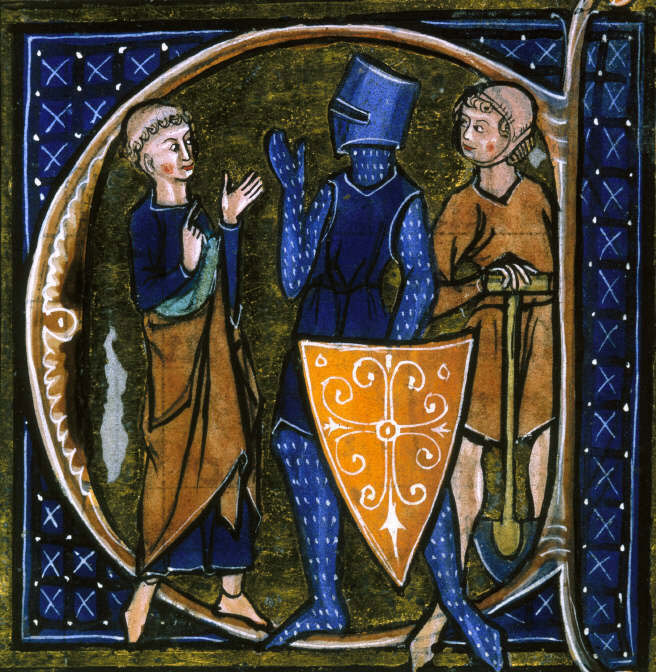This article is brought to you by Datawrapper, a data visualization tool for creating charts, maps, and tables. Learn more.
What can we learn from medieval prices and wages?

Hi, this is Mirko, co-founder and chairman of Datawrapper. This week we are going back in time, to England in the year 1340. The question: What does data tell us about the average person’s life?
The starting point for this Weekly Chart was a post by Vlad Zavidovych about prices and wages in medieval England, published on Medium in 2014. Reading through his findings, I found it amazing how a data-driven approach provides a different view on history — one that deals with the situation of the average person, instead of the usual focus on politics, wars, and major turning points. So, I asked the author whether I could link to his post and reproduce some of its charts. All quotes below are from Zavidovych unless otherwise attributed.
Is data from such a long time ago reliable?
Data on the Middle Ages is limited and incomplete compared to modern times, but there are still some reliable sources of information. For his post, Zavidovych used data from civic treasuries, merchants’ and bankers’ books, and town market records. Average wage estimates are based on the earnings of building craftsmen such as masons, carpenters, and thatchers. As historians explain, that’s because these occupations left unusually complete records and were paid by the day rather than for piecework.
One must still be careful in drawing general conclusions from the data snapshots below. Life was different in cities, where the food supply was more stable. Prices went up when the harvest was bad. Wages could include food and lodging in some cases, but not in others. The data is well researched, but we must still be cautious about thinking we know everything. That is generally good advice with any data.
Important context: Plague caused the death of 40–60% of the population
Between 1348 and 1350, the Black Death caused the death of 40–60% of the population. It took almost 300 years, until 1650, for the population to reach its previous levels.
Income inequality
Medieval society was highly unequal. This chart provides a comparison of wages across different classes — we will use a master mason's income to represent an "average" person in the rest of these charts.
“Mason wage was fairly representative of other 'middle class' citizens (merchants, clerks, craftsmen, etc.)”
💡 Money is expressed in pence (plural of penny) throughout this post. One pound = 20s (shillings/solidi) = 240d (pence/denarii). This is why the abbreviation for pence is “d.”
Food variety and a lot of beer
The average person in medieval England ate quite a varied diet — but the biggest expense was malt, for brewing beer at home. The result was called “small beer.” It had less alcohol than today’s beers and had a function as a nutritious drink. People had it for breakfast or drank beer during the day.
“Having a beer break was a medieval version of contemporary lunch.”
💡 A consumer basket is a fixed list of products used to track (and compare) price changes over time. The numbers below are based on the amount consumed by a typical person in one year.
Housing was expensive
Whether in the country or the city — in order to own a house you had to have money set aside. But in many professions that was almost impossible.
Annual expenses
Taxation was high. Many people had to either pay or work for people of a higher class.
What money could buy
Most people could not afford to buy anything nonessential. The up and down of life was surely more extreme than today. This system had an effect: There was not much hope of rising in society.
“After subtracting costs of basic consumer products, housing, [and] taxes, a typical mason would probably have some disposable income to treat himself to some good wine once in a while, buy an old horse, pay the guild fees. He wouldn’t be able to afford a more significant purchase, such as university education, armourer’s toolset, or knight’s equipment. Therefore, moving up a social class by simply working hard was not an option.”
Almost no inflation
When you went to the market, the prices could be different every month. But there was almost no long-term inflation — the value of the money stayed the same and the buying power remained.
“You could sell a house, bury the money, dig it out in 40 years, and buy the same house back.”
Observations
First of all: An analysis based on wages and prices is helpful for thinking and debating about economic issues we face today as well, such as housing or the rise of inflation we are experiencing in some western economies. Why is this type of data not the basis for more economic analysis of life today?
Secondly: Historians invested a lot of time to collect this data from sources, carefully comparing and updating the numbers to not make false claims. But a big challenge for me in reproducing the original blog post's findings was that its charts were static images. Meaning: There is no way of extracting the data, which is super simple with any Javascript chart today. It’s a good reminder of the value of making your underlying data publicly available along with your visualizations — someone years in the future might want to replicate your findings.
Many thanks to Vlad for letting us reuse this material. Next week we will have a Weekly Chart from our software engineer Marten.




Comments